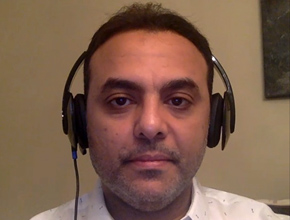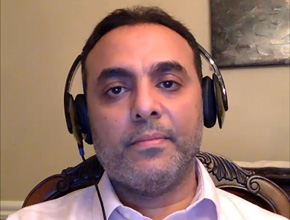Dr Waleed Alhazzani, associate professor in the Division of Critical Care at McMaster University, chair of Surviving Sepsis Campaign (SSC) guidelines, and lead author of the newest SSC guidelines focusing on coronavirus disease 2019 (COVID-19) in the critically ill, joins Dr Roman Jaeschke to discuss ventilatory support, including target oxygen levels, noninvasive ventilation, and intubation.
References
Alhazzani W, Møller MH, Arabi YM, et al. Surviving Sepsis Campaign: guidelines on the management of critically ill adults with Coronavirus Disease 2019 (COVID-19). Intensive Care Med. 2020 Mar 28. doi: 10.1007/s00134-020-06022-5. [Epub ahead of print] PubMed PMID: 32222812; PubMed Central PMCID: PMC7101866.For part 2 of this interview, click here. For part 4, click here.
Roman Jaeschke, MD, MSc: Good morning. We have the pleasure of having with us Professor Waleed Alhazzani again. We were talking about practice guidelines for critically ill patients, which will be very soon published in both European and North American critical care journals (Intensive Care Medicine, Critical Care Medicine).
In the previous episodes we talked about the methodology and structure of the guidelines and also discussed protecting health-care workers and patients. Let’s talk about supportive strategies.
Waleed Alhazzani, MBBS, MSc: In our guideline, as I mentioned before, we focused on 2 aspects of supportive care. One is ventilatory support, which includes pre–invasive mechanical ventilation management and what happens after those patients are intubated and invasively mechanically ventilated. The other aspect is hemodynamic support and it mostly focuses on those who develop shock while in the intensive care unit (ICU). Luckily, not a lot of patients with coronavirus disease 2019 (COVID-19) develop shock and the reports have been highly variable. But having said that, we thought it was an important piece of advice to help clinicians manage those patients.
Roman Jaeschke: Let’s start from the beginning, from the first part.
Waleed Alhazzani: Given that I like open questions, I’ll have some flexibility to go through things.
When you have a patient with COVID-19 who is hypoxic, the biggest question is what oxygen-delivering strategy we should be using. There’s not much direct high-quality evidence to help us provide recommendations with high certainty. We relied on indirect evidence from previous studies on coronaviruses, like Middle East respiratory syndrome coronavirus (MERS-CoV) and severe acute respiratory syndrome coronavirus 1 (SARS-CoV-1), and also on evidence from the general critically ill population while having input from experts who have managed many patients with respiratory failure from COVID-19.
I realize that there’ll be mixed and split opinions on this. This is why most of the recommendations in this section are conditional or weak recommendations, so mostly suggestions for clinicians.
You have a patient with COVID-19 who’s hypoxic. If there’s no immediate indication to intubate, the obvious treatment does not differ from other patients: you put them on oxygen. We say target an oxygen saturation between 92% to no more than 96%, because we know that higher oxygen levels, or hyperoxia, could be harmful. But additionally, recent randomized controlled trials (RCTs) have shown that even a conservative oxygen strategy targeting saturations lower than 92% might not be the best approach. So we issued a suggestion to initiate oxygen therapy and keep saturation above 92% and a recommendation not to exceed 96%, meaning that if the saturation reaches 96%, you can start weaning off oxygen. If the patient spontaneously has a saturation of 96% or above, you don’t need to prescribe oxygen. We also say that if saturation is lower than 90%, you absolutely have to start oxygen, obviously excluding patients with chronic obstructive pulmonary disease (COPD) or those who’re chronically hypoxic. That’s one key aspect of the recommendations: what oxygen levels to target.
The problem with COVID-19 patients, at least from the literature reports, is that they progressively get worse. The disease, at least from my understanding, is not that acutely fulminant from the onset of symptoms to developing respiratory failure. The mean or median time from the onset of symptoms to ICU admission, at least from Chinese literature that I’ve seen, was about 7 to 8 days. But once the patients get sick, the respiratory changes evolve quickly. If you look at radiological studies, they show that initially, in the first week, the patients may have minimal changes consistent with ground-glass opacities. In the second week, this progresses to bilateral ground-glass opacities with some consolidation. By the third week, it becomes a mixed disease with ground-glass changes on computed tomography (CT) scans plus extensive consolidation.
So it’s a mixed process. The delineation between acute respiratory distress syndrome (ARDS) and pneumonia might not be straightforward. I’m saying this just to prepare the audience for the next recommendations, because there’s a huge controversy about using high-flow nasal cannulas, noninvasive ventilation, or just jumping straight to intubating those patients early.
The dilemma is that recent studies from the MERS-CoV literature showed that in patients who were started on bilevel positive airway pressure (BiPAP), or noninvasive mechanical ventilation, there was a delay in intubation. The patients became very hypoxic when they got intubated. Most of them failed noninvasive ventilation. The issue is that we don’t know if this is because of, for instance, BiPAP-induced lung injury, if the noninvasive ventilation caused the lung problem, or if it’s because these patients simply weren’t monitored closely because everybody’s afraid to go to the room while the patient is on noninvasive ventilation. It’s all hard to draw conclusions from.
Nevertheless, I think the general feeling or interpretation of the literature is that those patients may fail noninvasive ventilation. This is why—and also based on the body of literature—it seems that high-flow nasal cannulas are well tolerated, and probably there’s less risk of aerosolization compared with noninvasive ventilation, so we say that if the patient needs more support, start with a high-flow nasal cannula. We made that a weak recommendation for using high-flow nasal cannulas over using noninvasive ventilation.
Having said that, clinicians should always have a low threshold to assess their patients frequently and to make sure that if there are the usual indications for intubation, the patient is intubated.
The more grey area comes with the questions, “What if all high-flow nasal cannulas have been used in the hospital and there are none available? Or if they are just not available in some institutions? Should we intubate everybody who doesn’t tolerate initial oxygen therapy? Or should we have a trial of noninvasive ventilation?” The context here is different. In an epidemic or pandemic context, when you have a large volume of patients, intubating everybody might also be a problem, with the shortage of ventilators. And when too many people are getting intubated, some of them could have been managed without invasive ventilation, and this may be causing harm to some patients. The problem is that we don’t have clear criteria saying who should be and who should not be intubated. We don’t have predictive scores in this specific population. Hopefully, with time, as we learn about this disease, maybe more studies will help us at least predict who is going to fail noninvasive ventilation and who should go straight to invasive mechanical ventilation.
Roman Jaeschke: So to summarize: 1) we should probably try to avoid noninvasive ventilation; 2) it’s probably OK to use high-flow nasal cannulas provided that we consider this—with some uncertainty—an aerosol-generating procedure; and 3) intubate earlier rather than later.
Who should be doing intubation? How is that discussed?
Waleed Alhazzani: We issued a best practice statement, so a strong recommendation, saying that an expert in airways, or whoever has the most experience in airways, should be intubating those patients. The reasons are that we should minimize the number of attempts; usually those experienced operators are skilled in rapid sequence intubation, or paralyzing the patients and intubating them quickly; and obviously those operators who are experienced may need fewer people in the room. So it’s a win-win situation to have these experienced colleagues doing those procedures.
Roman Jaeschke: I watched some reports from China where they had a team of physicians who were called for intubation. There was one group of people with meticulous personal protection who were the most skilled ones and carried supplies with them. Do you have an opinion on this?
Waleed Alhazzani: It’s a great idea. I think having a dedicated team makes sense, especially if there’s a high volume of patients who require intubation. You apply the essence of having an expert airway person doing intubation and probably the team will gain more experience, so that with time they will realize which patients may benefit from intubation and which may not, because they’ve seen more patients in distress than others. I think it’s a great idea.
One caveat is to ensure that maximum protection is used for this team as they get exposed to many patients when they are performing intubation.
Roman Jaeschke: Why don’t we stop here and we’ll cover the other parts of supportive care in the next interview. Thank you so much.
 English
English
 Español
Español
 українська
українська









